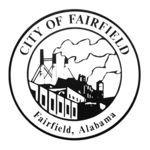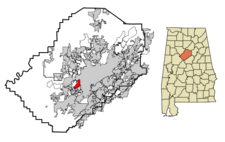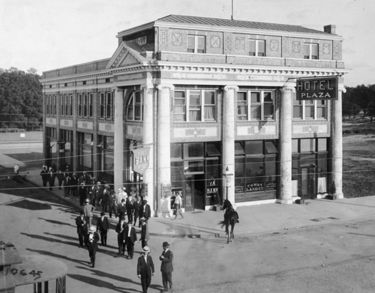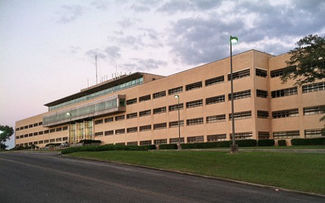Fairfield: Difference between revisions
No edit summary |
|||
| (48 intermediate revisions by 3 users not shown) | |||
| Line 1: | Line 1: | ||
{{Infobox City | name= | {{Infobox City | name=Fairfield | ||
| year= | | year=1919 | ||
| population= | | population=10,807 | ||
| mayor= | | mayor=Eddie Penny | ||
| | | fire=Fairfield Fire and Rescue | ||
| | | logo=[[Image:Fairfield seal.jpg|150px]] | ||
| | | map=[[Image:Fairfield locator map.png|225px]] | ||
| locate=Fairfield | | locate=Fairfield | ||
}} | }} | ||
'''Fairfield''', founded in [[1910]] and incorporated | '''Fairfield''', founded in [[1910]] and incorporated on [[January 1]], [[1919]] is a city in [[Jefferson County]], [[Alabama]] with a population of 10,807 on 3.47 square miles west of [[Birmingham]]. Originally named '''Corey,''' it was planned as a "model industrial city" by the [[Tennessee Coal, Iron and Railroad Company]] (TCI) to house workers in their [[Fairfield Works]] plant. | ||
==History== | |||
The Tennessee Company, active in the [[Birmingham District]] since [[1886]], was acquired by [[U. S. Steel]] in [[1907]]. The new owners began planning additional investments in the area, and, after a meeting with [[W. P. G. Harding]] of the [[First National Bank of Birmingham]], decided to lay out a new industrial city adjoining its proposed [[American Steel Wire Company]] plant in [[Possum Valley]], outside the [[Greater Birmingham|soon-to-be expanded]] [[Birmingham]] city limits. | |||
The [[Jemison Company]] was selected to develop the 256.4 acres of former farm land, and formed the [[Corey Land Company]] as a separate division. Jemison hired Boston landscape designer George H. Miller to produce a master plan which included a commercial and civic center, parks, and residential streets, with all the necessary landscaping and utilities. According to Miller's plan, no home lot would be more than 2 minutes' walk from a park or parkway. [[Miller, Martin & Lewis Architects|Miller & Martin]] of Birmingham produced design studies and drawings for supervisor's houses and typical workers' bungalows. A first public offering of business lots, held on [[June 28]], [[1910]] raised $350,000. Construction of major buildings by the land company began in March 1910 and was substantially completed, at a cost exceeding $1 million, by April [[1911]]. | |||
[[Image:Bank of Corey 1912.jpg|left|thumb|375px|Delegates to the Alabama Pharmaceutical Association, meeting in Birmingham, inspect the First Bank of Corey and the Plaza Hotel, c. 1912 {{BPL permission caption|http://cdm16044.contentdm.oclc.org/cdm/ref/collection/p4017coll6/id/2285}}]] | |||
Originally named for William Ellis Corey, the second president of U. S. Steel, the city was renamed in [[1913]], two years after Corey's resignation in the wake of divorcing his estranged wife, Laura, in order to marry Broadway chorus girl Mabelle Gilman. The name "Fairfield" honors the Connecticut birthplace of Corey's successor, James Farrell. | |||
In [[1919]] the City of Fairfield, with about 5,000 residents, was incorporated as a municipality with [[A. Clinton Decker]] as its first [[Mayor of Fairfield|mayor]]. The corporate limits included nearby [[Miles College]], which was granted land near the planned city by TCI in exchange for turning its former [[Booker City]] campus over to the company to develop the [[Docena]] coal mine. Later that year the [[Lloyd Noland Hospital|TCI Employees Hospital]] opened, headed by [[Lloyd Noland]]. The first [[Fairfield City Hall]] was an office in the [[Carmichael Building]] at 4604½ [[Gary Avenue]]. [[Fairfield Industrial High School]] opened in [[1924]] and [[Fairfield High School]] for white students followed in [[1928]]. | |||
U. S. Steel's Fairfield Works grew rapidly as its primary steel manufacturing facility in the district, and accounted for as many as 45,000 jobs at its peak during [[World War II]]. A new [[Fairfield City Hall]] was completed, with assistance from the [[Works Progress Administration]], in [[1945]]. | |||
Commercial development followed, peaking with the dedication of [[Western Hills Mall]] in [[1970]], followed by [[Belleview Plaza]] in [[1972]]. The [[Flintridge Shopping Center]] opened in [[1991]] with a Home Depot. A Wal-Mart Supercenter opened on the former Western Hills Mall site in [[2006]]. | |||
[[Image:Flintridge Building.jpg|right|thumb|325px|The Flintridge Building]] | |||
As the fortunes of the steel plant waned, the city declined with it. By [[2010]] Fairfield Works employed fewer than 2,000 people, and the blast furnace was shut down entirely in [[2015]], shedding more than 1,100 more jobs. [[Lloyd Noland Hospital]] closed in [[2004]] and was subsequently purchased by Miles College for a campus expansion. Licensed [[electronic bingo]] parlors filled numerous vacancies and provided revenue to the city in [[2009]], but were shut down in [[2010]] for not complying with state law. The Wal-Mart closed in [[2016]], costing the city it's largest single source of sales tax revenues. | |||
In February [[2019]] the [[Jefferson County Commission]] agreed to maintain [[Valley Road]], [[Aaron Aronov Drive]] and [[Rutledge Drive]] at no cost to the city. | |||
In May 2020, the city declared bankruptcy. Major creditors included U.S. Bank, the [[Fairfield Board of Education]], [[Alabama Power]], [[Birmingham Water Works]], [[Regions Bank]] and the Internal Revenue Service. After the city renegotiated settlements with Ambac Assurance Corp. and U.S. Bank it successfully petitioned Judge [[Tamara O. Mitchell]] to dismiss the bankruptcy suit on [[January 8]], [[2024]]. The city still expected to face other creditors in court. | |||
==Government== | ==Government== | ||
The [[Mayor of Fairfield]] is [[ | The [[Mayor of Fairfield]] is [[Eddie Penny]], former City Council president. The [[Fairfield City Council]] consists of [[Barakas Taylor]], [[Susan Jo Rembert-Parks]], [[Cynthia Turner-McDowell]], [[John Hackett]], [[Herman Carnes]], and [[Willie Hardley]]. In February [[2018]] the Council created a new position of City Manager by ordinance and appointed [[Mary Roberson]] to the position. The ordinance was struck down by [[Jefferson County Circuit Court]] Judge [[Pat Ballard]] in September. | ||
The city operates the [[Fairfield Police Department]] and [[Fairfield Fire and Rescue]] department. The city also has an independent [[Fairfield City Schools]] system with three primary schools feeding into [[Fairfield High Preperatory School]], along with an alternative all-grades school. The city also owns the [[Walter J. Hanna Public Library]] and its [[Fairfield Housing Authority]] manages the [[Mattie Gill Jones Gardens]], [[Demetrius C. Newton Gardens]], and [[W. Clyde Williams Terrace]] apartment communities. | |||
==Demographics== | ==Demographics== | ||
As of the Census of | As of the Census of 2010, there were 11,117 people residing in the city's 4,935 housing units, for an average household size of 2.25 persons. The population density was 3,202.6/mi², with housing units at an average density of 1,421.7/mi². The racial makeup of the city was 94.6% African American and 4.2% White. 1.14% of the population was Hispanic or Latino of any race. | ||
In [[2000]], there were 4,600 households, of which 34% had children under the age of 18 living with them, 36% were married couples living together, 28% had a female householder with no husband present, and 32% were non-families. 29% of all households were made up of individuals and 12% had someone living alone who was 65 years of age or older. The average household size was 2.55 and the average family size was 3.17. | |||
In the city the population was spread out with 27% under the age of 18, 12% from 18 to 24, 25% from 25 to 44, 22% from 45 to 64, and 14% who were 65 years of age or older. The median age was 36 years. For every 100 females there were 79.2 males. For every 100 females age 18 and over, there were 73.4 males. | In the city the population was spread out with 27% under the age of 18, 12% from 18 to 24, 25% from 25 to 44, 22% from 45 to 64, and 14% who were 65 years of age or older. The median age was 36 years. For every 100 females there were 79.2 males. For every 100 females age 18 and over, there were 73.4 males. | ||
| Line 25: | Line 48: | ||
The [[Jefferson County Board of Equalization]] evaluated 3,643 homes in Fairfield and determined that the average market value for 2007 was $87,191, a 7.4% increase since 2006. | The [[Jefferson County Board of Equalization]] evaluated 3,643 homes in Fairfield and determined that the average market value for 2007 was $87,191, a 7.4% increase since 2006. | ||
== | ===Fairfield population 1920-2016=== | ||
'''year''' '''pop.''' '''%change''' | |||
1920 | 5,003 | - | |||
1930 | 11,059 | +121.0% | |||
1940 | 11,703 | +5.8% | |||
1950 | 13,177 | +12.6% | |||
1960 | 15,816 | +20.0% | |||
1970 | 14,369 | -9.1% | |||
1980 | 13,242 | -7.8% | |||
1990 | 12,200 | -7.9% | |||
2000 | 12,381 | -1.5% | |||
2010 | 11,117 | -10.2% | |||
2020 | 10,000 | -10.0% | |||
2022 | 9,690 | -3.1% | |||
==References== | ==References== | ||
* " | * "Corey--The Model Industrial City of the South--To be a Revelation to the Entire Industrial World." (May 2010) ''Jemison Magazine'' Vol. 1, No. 1, pp. 8-9, rpt. in Birmingham Historical Society (2011) ''[http://digital.archives.alabama.gov/cdm/compoundobject/collection/hgpub/id/55225/rec/1 The Jemison Magazine and the Selling of Birmingham, 1910-1914]'' ISBN 9780943994369 | ||
* {{White-1981}} | |||
* {{Morris-1989}} | |||
* "[http://en.wikipedia.org/w/index.php?title=Fairfield,_Alabama Fairfield, Alabama] (June 23, 2010) Wikipedia - accessed August 8, 2010 | |||
* Norris, Toraine (August 8, 2010) "[https://www.al.com/spotnews/2010/08/built_around_steel_industry_fa.html Built around steel industry, Fairfield hopes Miles College can bring it second life]." {{BN}} | |||
* Davis, Mark (October 16, 2015) "[https://www.ajc.com/news/city-steels-itself-for-change/LnEN38YXlal9jrPESDY1wJ/ City steels itself for change]." ''The Atlanta Journal-Constitution'' | |||
* Barrett, Brian (January 30, 2016) "[https://www.newyorker.com/business/currency/when-walmart-leaves-town When Walmart Leaves Town]." ''The New Yorker'' | |||
* Prickett, Sam (March 22, 2016) "Inside Fairfield’s Financial Crisis." {{Weld}} | |||
* Koplowitz, Howard (September 24, 2018) "Judge rules Fairfield city manager position void." {{BN}} | |||
* Robinson, Carol (February 13, 2019) "Fairfield mayor ousted from office, city council president sworn in as mayor." {{BN}} | |||
* Faulk, Kent & Howard Koplowitz (May 20, 2020) "[https://www.al.com/news/2020/05/city-of-fairfield-files-for-bankruptcy.html City of Fairfield files for bankruptcy]." {{BN}} | |||
* Denham, Hannah (September 24, 2023) "[https://www.al.com/news/2023/09/an-alabama-city-wants-to-leave-bankruptcy-even-as-it-owes-millions.html An Alabama city wants to leave bankruptcy, even as it owes millions.]" {{AL}} | |||
* Denham, Hannah (January 11, 2024) "[https://www.al.com/business/2024/01/this-alabama-city-closed-its-bankruptcy-case-it-still-owes-millions.html This Alabama city closed its bankruptcy case. It still owes millions]." {{AL}} | |||
{{Jefferson County}} | {{Jefferson County}} | ||
| Line 47: | Line 84: | ||
[[Category:Company towns]] | [[Category:Company towns]] | ||
[[Category:Planned communities]] | [[Category:Planned communities]] | ||
[[Category:Jemison developments]] | |||
[[Category:1919 establishments]] | |||
Latest revision as of 10:44, 12 January 2024
| City of Fairfield | |

| |
| Incorporated | 1919 |
|---|---|
| Population | 10,807 |
| Mayor | Eddie Penny |
| School district | Fairfield City Schools |
| Government |
Fairfield City Council |
| Web site | None |

| |
| Locate with Google Maps | |
Fairfield, founded in 1910 and incorporated on January 1, 1919 is a city in Jefferson County, Alabama with a population of 10,807 on 3.47 square miles west of Birmingham. Originally named Corey, it was planned as a "model industrial city" by the Tennessee Coal, Iron and Railroad Company (TCI) to house workers in their Fairfield Works plant.
History
The Tennessee Company, active in the Birmingham District since 1886, was acquired by U. S. Steel in 1907. The new owners began planning additional investments in the area, and, after a meeting with W. P. G. Harding of the First National Bank of Birmingham, decided to lay out a new industrial city adjoining its proposed American Steel Wire Company plant in Possum Valley, outside the soon-to-be expanded Birmingham city limits.
The Jemison Company was selected to develop the 256.4 acres of former farm land, and formed the Corey Land Company as a separate division. Jemison hired Boston landscape designer George H. Miller to produce a master plan which included a commercial and civic center, parks, and residential streets, with all the necessary landscaping and utilities. According to Miller's plan, no home lot would be more than 2 minutes' walk from a park or parkway. Miller & Martin of Birmingham produced design studies and drawings for supervisor's houses and typical workers' bungalows. A first public offering of business lots, held on June 28, 1910 raised $350,000. Construction of major buildings by the land company began in March 1910 and was substantially completed, at a cost exceeding $1 million, by April 1911.

Originally named for William Ellis Corey, the second president of U. S. Steel, the city was renamed in 1913, two years after Corey's resignation in the wake of divorcing his estranged wife, Laura, in order to marry Broadway chorus girl Mabelle Gilman. The name "Fairfield" honors the Connecticut birthplace of Corey's successor, James Farrell.
In 1919 the City of Fairfield, with about 5,000 residents, was incorporated as a municipality with A. Clinton Decker as its first mayor. The corporate limits included nearby Miles College, which was granted land near the planned city by TCI in exchange for turning its former Booker City campus over to the company to develop the Docena coal mine. Later that year the TCI Employees Hospital opened, headed by Lloyd Noland. The first Fairfield City Hall was an office in the Carmichael Building at 4604½ Gary Avenue. Fairfield Industrial High School opened in 1924 and Fairfield High School for white students followed in 1928.
U. S. Steel's Fairfield Works grew rapidly as its primary steel manufacturing facility in the district, and accounted for as many as 45,000 jobs at its peak during World War II. A new Fairfield City Hall was completed, with assistance from the Works Progress Administration, in 1945.
Commercial development followed, peaking with the dedication of Western Hills Mall in 1970, followed by Belleview Plaza in 1972. The Flintridge Shopping Center opened in 1991 with a Home Depot. A Wal-Mart Supercenter opened on the former Western Hills Mall site in 2006.
As the fortunes of the steel plant waned, the city declined with it. By 2010 Fairfield Works employed fewer than 2,000 people, and the blast furnace was shut down entirely in 2015, shedding more than 1,100 more jobs. Lloyd Noland Hospital closed in 2004 and was subsequently purchased by Miles College for a campus expansion. Licensed electronic bingo parlors filled numerous vacancies and provided revenue to the city in 2009, but were shut down in 2010 for not complying with state law. The Wal-Mart closed in 2016, costing the city it's largest single source of sales tax revenues.
In February 2019 the Jefferson County Commission agreed to maintain Valley Road, Aaron Aronov Drive and Rutledge Drive at no cost to the city.
In May 2020, the city declared bankruptcy. Major creditors included U.S. Bank, the Fairfield Board of Education, Alabama Power, Birmingham Water Works, Regions Bank and the Internal Revenue Service. After the city renegotiated settlements with Ambac Assurance Corp. and U.S. Bank it successfully petitioned Judge Tamara O. Mitchell to dismiss the bankruptcy suit on January 8, 2024. The city still expected to face other creditors in court.
Government
The Mayor of Fairfield is Eddie Penny, former City Council president. The Fairfield City Council consists of Barakas Taylor, Susan Jo Rembert-Parks, Cynthia Turner-McDowell, John Hackett, Herman Carnes, and Willie Hardley. In February 2018 the Council created a new position of City Manager by ordinance and appointed Mary Roberson to the position. The ordinance was struck down by Jefferson County Circuit Court Judge Pat Ballard in September.
The city operates the Fairfield Police Department and Fairfield Fire and Rescue department. The city also has an independent Fairfield City Schools system with three primary schools feeding into Fairfield High Preperatory School, along with an alternative all-grades school. The city also owns the Walter J. Hanna Public Library and its Fairfield Housing Authority manages the Mattie Gill Jones Gardens, Demetrius C. Newton Gardens, and W. Clyde Williams Terrace apartment communities.
Demographics
As of the Census of 2010, there were 11,117 people residing in the city's 4,935 housing units, for an average household size of 2.25 persons. The population density was 3,202.6/mi², with housing units at an average density of 1,421.7/mi². The racial makeup of the city was 94.6% African American and 4.2% White. 1.14% of the population was Hispanic or Latino of any race.
In 2000, there were 4,600 households, of which 34% had children under the age of 18 living with them, 36% were married couples living together, 28% had a female householder with no husband present, and 32% were non-families. 29% of all households were made up of individuals and 12% had someone living alone who was 65 years of age or older. The average household size was 2.55 and the average family size was 3.17.
In the city the population was spread out with 27% under the age of 18, 12% from 18 to 24, 25% from 25 to 44, 22% from 45 to 64, and 14% who were 65 years of age or older. The median age was 36 years. For every 100 females there were 79.2 males. For every 100 females age 18 and over, there were 73.4 males.
The median income for a household in the city was $27,845, and the median income for a family was $38,552. Males had a median income of $30,833 versus $25,143 for females. The per capita income for the city was $14,607. About 16.5% of families and 21.5% of the population were below the poverty line, including 27.7% of those under age 18 and 25.3% of those age 65 or over.
The Jefferson County Board of Equalization evaluated 3,643 homes in Fairfield and determined that the average market value for 2007 was $87,191, a 7.4% increase since 2006.
Fairfield population 1920-2016
year pop. %change 1920 | 5,003 | - 1930 | 11,059 | +121.0% 1940 | 11,703 | +5.8% 1950 | 13,177 | +12.6% 1960 | 15,816 | +20.0% 1970 | 14,369 | -9.1% 1980 | 13,242 | -7.8% 1990 | 12,200 | -7.9% 2000 | 12,381 | -1.5% 2010 | 11,117 | -10.2% 2020 | 10,000 | -10.0% 2022 | 9,690 | -3.1%
References
- "Corey--The Model Industrial City of the South--To be a Revelation to the Entire Industrial World." (May 2010) Jemison Magazine Vol. 1, No. 1, pp. 8-9, rpt. in Birmingham Historical Society (2011) The Jemison Magazine and the Selling of Birmingham, 1910-1914 ISBN 9780943994369
- White, Marjorie Longenecker (1981) The Birmingham District: An Industrial History and Guide. Birmingham: Birmingham Historical Society ISBN 9990230099
- Morris, Philip A. and Marjorie Longenecker White, eds. (1989) Designs on Birmingham: A Landscape History of a Southern City and Its Suburbs Birmingham: Birmingham Historical Society
- "Fairfield, Alabama (June 23, 2010) Wikipedia - accessed August 8, 2010
- Norris, Toraine (August 8, 2010) "Built around steel industry, Fairfield hopes Miles College can bring it second life." The Birmingham News
- Davis, Mark (October 16, 2015) "City steels itself for change." The Atlanta Journal-Constitution
- Barrett, Brian (January 30, 2016) "When Walmart Leaves Town." The New Yorker
- Prickett, Sam (March 22, 2016) "Inside Fairfield’s Financial Crisis." Weld for Birmingham
- Koplowitz, Howard (September 24, 2018) "Judge rules Fairfield city manager position void." The Birmingham News
- Robinson, Carol (February 13, 2019) "Fairfield mayor ousted from office, city council president sworn in as mayor." The Birmingham News
- Faulk, Kent & Howard Koplowitz (May 20, 2020) "City of Fairfield files for bankruptcy." The Birmingham News
- Denham, Hannah (September 24, 2023) "An Alabama city wants to leave bankruptcy, even as it owes millions." AL.com
- Denham, Hannah (January 11, 2024) "This Alabama city closed its bankruptcy case. It still owes millions." AL.com
| Jefferson County | |
|---|---|
| Topics |
Communities | County Commission | Courts | Schools | Sheriff |
| Cities |
Adamsville | Bessemer (seat) | Birmingham (seat) | Brighton | Brookside | Cardiff | Center Point | Clay | Fairfield | Fultondale | Gardendale | Graysville | Homewood | Hoover | Hueytown | Irondale | Kimberly | Leeds | Lipscomb | Maytown | Midfield | Morris | Mountain Brook | Mulga | North Johns | Pinson | Pleasant Grove | Sylvan Springs | Tarrant | Trafford | Trussville | Vestavia Hills | Warrior | West Jefferson |
